英语语言学概论Phonology
- 格式:doc
- 大小:54.00 KB
- 文档页数:7
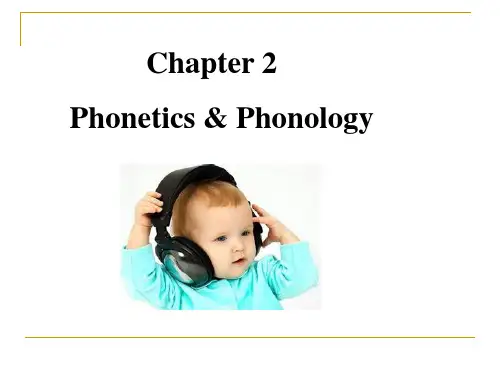



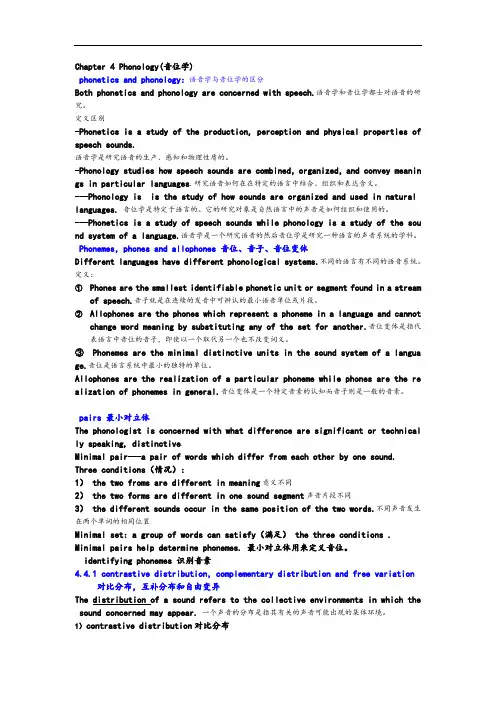
Chapter 4 Phonology(音位学)phonetics and phonology:语音学与音位学的区分Both phonetics and phonology are concerned with speech.语音学和音位学都士对语音的研究。
定义区别-Phonetics is a study of the production, perception and physical properties of speech sounds.语音学是研究语音的生产、感知和物理性质的。
-Phonology studies how speech sounds are combined,organized,and convey meanin gs in particular languages.研究语音如何在在特定的语言中结合、组织和表达含义。
---Phonology is is the study of how sounds are organized and used in natural languages.音位学是特定于语言的。
它的研究对象是自然语言中的声音是如何组织和使用的。
---Phonetics is a study of speech sounds while phonology is a study of the sou nd system of a language.语音学是一个研究语音的然后音位学是研究一种语言的声音系统的学科。
Phonemes,phones and allophones 音位、音子、音位变体Different languages have different phonological systems.不同的语言有不同的语音系统。
定义:①Phones are the smallest identifiable phonetic unit or segment found in a streamof speech.音子就是在连续的发音中可辨认的最小语音单位或片段。
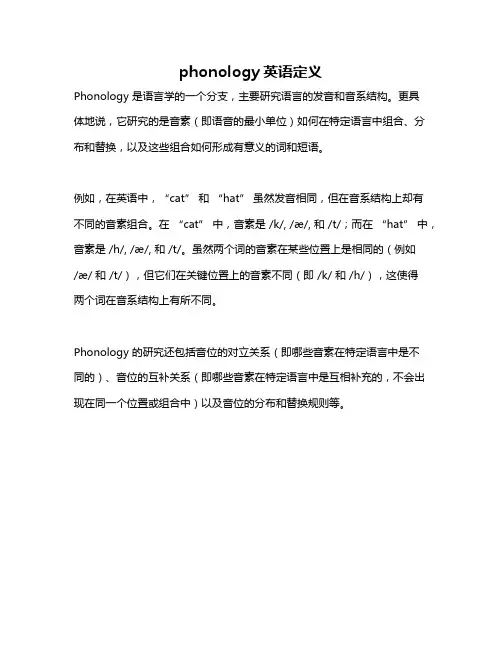
phonology英语定义
Phonology 是语言学的一个分支,主要研究语言的发音和音系结构。
更具
体地说,它研究的是音素(即语音的最小单位)如何在特定语言中组合、分布和替换,以及这些组合如何形成有意义的词和短语。
例如,在英语中,“cat” 和“hat” 虽然发音相同,但在音系结构上却有不同的音素组合。
在“cat” 中,音素是/k/, /æ/, 和 /t/;而在“hat” 中,音素是/h/, /æ/, 和 /t/。
虽然两个词的音素在某些位置上是相同的(例如
/æ/ 和 /t/),但它们在关键位置上的音素不同(即 /k/ 和 /h/),这使得
两个词在音系结构上有所不同。
Phonology 的研究还包括音位的对立关系(即哪些音素在特定语言中是不
同的)、音位的互补关系(即哪些音素在特定语言中是互相补充的,不会出现在同一个位置或组合中)以及音位的分布和替换规则等。

语言学Chapter3PhonologyChapter 3 PhonologyAims:1) To have an understanding of the differences between phonology and phonetics;2) To let the students know some terms in phonology, such as phoneme, allophone, phonemiccontrast, complementary distribution and so on;3) To be familiar with the distinctive features and some phonological rules;4) To understand what suprasegmental features are.1. Phonology and phoneticsPhonology is the study of sound systems—the inventory of distinctive sounds that occur in a language and the patterns into which they fall, how the sound system of a language functions.Both phonology and phonetics are studies of speech sounds.The two words contain the same root phono-,meaning sounds.But while both are related to the study of sounds,they differ in their approach and focus. As we have seen in the last chapter,phonetics is of a general nature;it is interested in all the speech sounds used in all human languages:how they are produced,how they differ from each other,what phonetic features they possess,how they can be classified,etc. Phonology,on the other hand,is interested in the system of sounds of a particular language;it aims to discover how speech sounds in a language form patterns and how these sounds are used to convey meaning in linguistic communication.Thus these two are at once related and distinct branches of linguistic studies.Phonology, therefore, different from phonetics, is language specific. It deals with speech sounds within the context of a particular language.2. Phoneme and allophonePhonology is concerned with the speech sounds which distinguish meaning. So the subtle difference between clear [l] and dark [l] and that between alveolar [n] and dental [n] are not really the concern of phonology, but the difference between [p] and [b] and that between [l] and [m] are because [pi:] (pea) and [bi:] (bee), and [leik] and [meik] are entirely different in meaning. The basic unit in phonology is called phoneme; it is a unit that is of distinctive value. But is an abstract unit. To be exact, a phoneme is not a sound; it is a collection of distinctive phonetic features. In actual speech, a phoneme is realized phonetically as a certain phone. The different phones which can represent a phoneme in different phonetic environments are called the allophones of that phoneme.3. Phonemic contrast, complementary distribution and minimal pairPhonetically similar sounds might be related in two ways. They might form a contrast if they aretwo distinctive phonemes,or they do not form a contrast in meaning if they are allophones of the same phoneme. Study the pronunciation of the following words:Rope[r[Up],robe[r[Ub],pin[phin],bin [bin],pot [phCt]spot[spCt]We can see that [ph] and[b]contras each other in initial position,as in pin and bin. Then we find that they also contrast in final position,as in rope and robe. So we come to the conclusion that /p/ and /b/ can occur in the same environmentsand they distinguish meaning:therefore they are in phonemic contrast. On the other hand,[p]and [ph]never contrast each other. They are two allophones of the same phoneme /p/. They occur in different environmentsThese two allophones of the same phoneme are said to be in complementary distribution.When confronted with an unfamiliar language,a linguist has,first of all,to find out what are the sounds that convey meaning in that language,namely,the phonemes that form the sound system of that particular language.A basic way to determine the phonemes of language is to see if substituting one sound for another results in a change of meaning. If it does, the two sounds then represent different phonemes. An easy way to do this is to find the minimal pairs. When two different forms are identical in every way except for one sound segment which occurs in the same place in the strings, the two words are said to form a minimal pair.4. Phonological rules4.1 Sequential rulesThere are rules that govern the combination of sounds in a particular language. These rules are called sequential rules. There are many such sequential rules in English. For example, if a word begins with a [l] or a [r], then the next sound must be a vowel. That is why [ibik] and [ikbi] are impossible combinations in English.If three consonants should cluster together at the beginning of a word, the combination should obey the following three rules:1) the first phoneme must be /s/;2) the second phoneme must be /p/ or /t/ or /k/;3) the third phoneme must be /l/ or /r/ or /w/.This is why all words beginning with a combination of threeconsonants in English are words like spring, strict, square, splendid, scream.4.2 Assimilation rulesThe assimilation rule assimilates one sound to another by “copying” a feature of a sequential pho neme, thus making the two phones similar.For example, [i:] sound is non-nasalized in such words as tea, peep, flee, it is nasalized in words like bean, green, team and scream. This is because in al these sound combination the [i:] sound is followed by a nasal [n] or [m]. While we are pronouncing the [i:] sound, we are already getting ready to pronounce the subsequent nasal sound. Nasalize a vowel when it is followed bya nasal sound.4.3 Deletion ruleIt tells us when a sound is to be deleted although it is orthographically represented.4.4 Distinctive featuresAs we have seen from the discussion of IPA symbols in the last chapter; speech sounds are divided up into classes according to a number of properties. One important property is “voicing”, which plays an important part in distinguish obstruents(阻塞音)in English. Because voicing can distinguish one phoneme from another, it is a distinctive feature for English obstruents. There are other features too and many of them are binary features. eg, [+voiced] [+nasal] [+round].5. Suprasegmental features (refer to Poole, 2000: 66)5.1 SyllableSyllable is a unit in speech which is often longer than one sound and smaller than a whole word. The syllable consists of three parts: onset, the peak, coda. Every syllable has a nucleus,its power source. This is usually a vowel but it can also be a liquid or nasal consonant as in the second syllable of the word “people” [5pi:pl]. A syllable may consist of nothing but the nucleus, as in the word “owe”, but the nucleus is usua lly accompanied by at least one consonant.A preceding consonant or consonant cluster is called an onset and a following.5.2 StressThe pronunciation of a word or syllable with more force than the surrounding words or syllables.A stressed word or syllable is produced by using more air from the lungs.Stress has two main semantic functions:a. It may distinguish between two wordsb. The speaker wishes to emphasize the syllable or word.Pitch: different rates of vibration of vocal cord caused different pitch. Pitch variations may be distinctive like phonemes.5.3 IntonationWhen pitch, stress and length variations are tied to the sentence rather than to the word, they are collectively known as Intonation. Intonation has four grammatical functions: First, it may indicate different sentence types by pitch direction.Second, sometimes the different pitch direction may indicate connotative meanings.Third, it may impose different structure on the sentence by dividing it into different intonation units.Fourth, intonation may bring part of a sentence into prominence by placing the nucleus (the major pitch change) on the syllable concerned. Stress, intonation and length can all makea word more prominent than the quality of its component sounds allows. But of the three, intonation is the most effective means while stress is the least, in spite of the erroneous assumption that the sole function of stress is to give emphasis to a word.Intonation also has attitudinal functions. It may indicate the emotional state of the speaker---whether he is calm or exited, happy or sad.Exercise:1. What criteria are used to classify the English consonants and vowels?2. Give the phonetic symbol for each of the following sound description:1) voiced palatal affricate 2) voiceless labiodental fricative 3) voiced alveolar stop 4) front, close, short 5) back, semi-open, long 6) voiceless bilabial stop3. Give the phonetic features of each of the following sounds:[d] [l] [tF] [w] [U] [A ]4. How do phonetics phonology differ in their focus of study? Who do you think will be more interested in the difference between, say [l] and [l], [] and [ph], a phonetician or a phonologist? Why?5. Explain with examples the sequential rule, the assimilation rule and the deletion rule.6. What is the test used for determining phonemes in a language?。

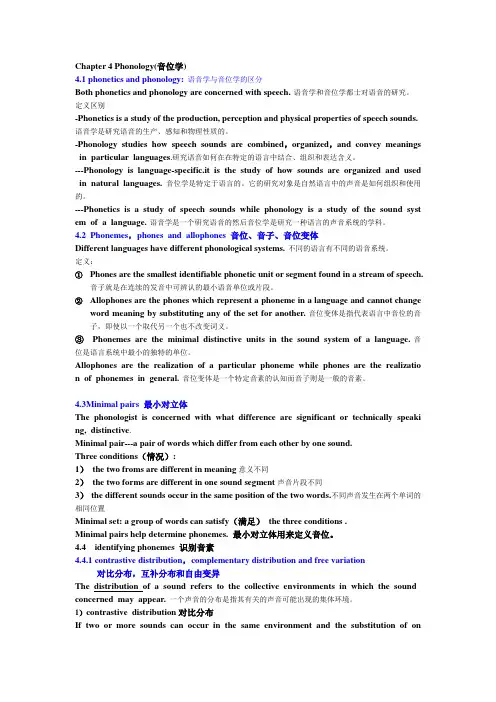
Chapter 4 Phonology(音位学)4.1 phonetics and phonology:语音学与音位学的区分Both phonetics and phonology are concerned with speech.语音学和音位学都士对语音的研究。
定义区别-Phonetics is a study of the production, perception and physical properties of speech sounds. 语音学是研究语音的生产、感知和物理性质的。
-Phonology studies how speech sounds are combined,organized,and convey meanings in particular languages.研究语音如何在在特定的语言中结合、组织和表达含义。
---Phonology is language-specific.it is the study of how sounds are organized and used in natural languages.音位学是特定于语言的。
它的研究对象是自然语言中的声音是如何组织和使用的。
---Phonetics is a study of speech sounds while phonology is a study of the sound syst em of a language.语音学是一个研究语音的然后音位学是研究一种语言的声音系统的学科。
4.2 Phonemes,phones and allophones 音位、音子、音位变体Different languages have different phonological systems.不同的语言有不同的语音系统。
定义:①Phones are the smallest identifiable phonetic unit or segment found in a stream of speech.音子就是在连续的发音中可辨认的最小语音单位或片段。

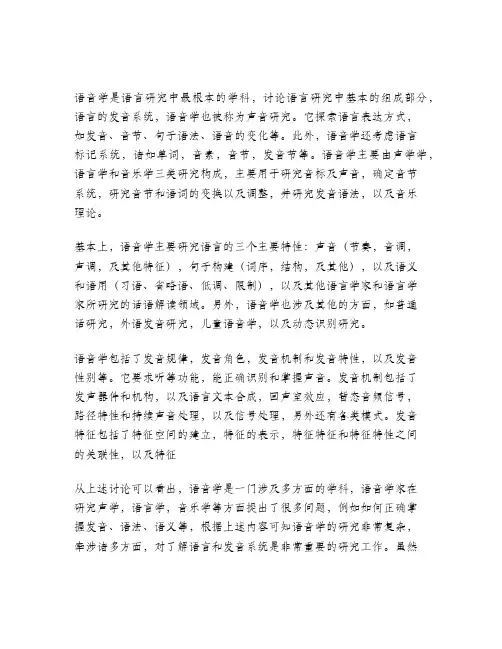
语音学是语言研究中最根本的学科,讨论语言研究中基本的组成部分,语言的发音系统,语音学也被称为声音研究。
它探索语言表达方式,
如发音、音节、句子语法、语音的变化等。
此外,语音学还考虑语言
标记系统,诸如单词,音素,音节,发音节等。
语音学主要由声学学,语言学和音乐学三类研究构成,主要用于研究音标及声音,确定音节
系统,研究音节和语词的变换以及调整,并研究发音语法,以及音乐
理论。
基本上,语音学主要研究语言的三个主要特性:声音(节奏,音调,
声调,及其他特征),句子构建(词序,结构,及其他),以及语义
和语用(习语、省略语、低调、限制),以及其他语言学家和语言学
家所研究的话语解读领域。
另外,语音学也涉及其他的方面,如普通
话研究,外语发音研究,儿童语音学,以及动态识别研究。
语音学包括了发音规律,发音角色,发音机制和发音特性,以及发音
性别等。
它要求听等功能,能正确识别和掌握声音。
发音机制包括了
发声器件和机构,以及语言文本合成,回声室效应,暂态音频信号,
路径特性和持续声音处理,以及信号处理,另外还有各类模式。
发音
特征包括了特征空间的建立,特征的表示,特征特征和特征特性之间
的关联性,以及特征
从上述讨论可以看出,语音学是一门涉及多方面的学科,语音学家在
研究声学,语言学,音乐学等方面提出了很多问题,例如如何正确掌
握发音、语法、语义等,根据上述内容可知语音学的研究非常复杂,
牵涉诸多方面,对了解语言和发音系统是非常重要的研究工作。
虽然
语音学的研究和探索是一个不断发展的过程,但是它的重要性无可否认,因为它从根。
Chapter 2 Phonology音系学一、本章纲要二、本章重点1.The phonic medium of language语言的声音媒介Of two media of language, speech is more basic than writing, for the reasons:1)In linguistic evolution, speech is prior to writing;2)In everyday communication, speech plays a greater role in terms of the amount of information conveyed;3)Speech is always the way in which every native speaker acquires his mother tongue, and writing is learned and taught later in school.The phonic medium of language语言的声音媒介(2006填空;2001,32名词解释)This limited range of sounds which are meaningful in human communication and are of interest to linguistic are the phonic medium of language; and the individual sounds within this range are the speech sounds (语音).2.Phonetics语音学2.1 What is phonetics? 什么是语音学Phonetics is defined as the study of the phonic medium of language; it is concerned with all the sounds that occur in the world‟s languages.语音学研究的对象是语言的声音媒介,即人类语言中使用的全部语音。
Phonology(音位学)Phonetics is a study of the production,transmission and perception of speech sounds, and their physical properties.Phonemes音位are the minimal distinctive units in the sound system of a language. Allophones 音位变体are the different realizations of a particular phoneme in a language. Phones are the smallest identifiable phonetic unit or segment in a stream of speech.Minimal pair最小对立体:a pair of words which differ from each other by one sound.3 conditions: 1 the two forms are different in meaning; 2 the two forms are different in one segment; 3 the different sounds occur in the same position of the two words: teach---cheat, read—dearIf two or more sounds never appear in the same enviornment, that is, each sound only appears in the enviornment where the other never occurs, they are in complementary distribution.互补分布pen—pet, pat—spat—tap, lead—realIf two or more sounds can occur in the same environment and the substitution of one sound for another brings about a change of meaning, they are in contrastive distribution.Will—till 对比分布When two sounds can appear in the same environment and the substitution of one for the other does not cause any change in meaning, they are in free variation. 自由变体A distinctive feature区别性特征is one which distinguishes one phoneme from another,like /nasal/,/voiced/. put forward by Jakobson.The assimilation rule同化原则the effect of phonetic context or situation on a particular phone.Deletion rule删除: delete a sound although it is orthographically represented Sequential rules顺序:state the possible combination of phonemes and the constraints over such a combination for a language.suprasegmental features(超切分特征) features that have effect on more than one segment, which also known as prosody(韵律语音特征): stress, tone, intonation and juncture.stress(重音,重读) some nouns are stressed on the first syllables while the verbs are stressed on the second syllables:Tone(声调): the level of pitch that is used in a linguistically contrastive ways.Tone language: ma ma ma ma(妈,麻马骂)Intonation(语调) 5 intonations: the falling tones: certainty; the rising tones: uncertainty, the level tones: undecided yet whether known or unknown,juncture(连音): the boundary features that may demarcate grammatical units:A name an aimnarrow transcription(严式音标):symbolizes all the possible speech sounds, broad transcription(宽式音标): transcribes or indicates only the only those speech sounds that distinguish one word from another in a language . It is phonemic.。